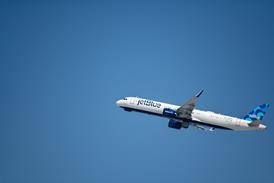Avionics maker Honeywell plans to offer a synthetic vision system (SVS) developed exclusively for helicopters by 2010. Anchored by the company's helicopter-specific enhanced ground proximity warning system (H-EGPWS), the display will render a three-dimensional view of terrain and obstacles along the flightpath and ultimately point out unmapped real-time threats, like wires and trees.
The research programme follows development of an SVS for fixed-wing aircraft, the Integrated Primary Flight Display (IPFD), which launch customer Gulfstream will this year offer on high-end business jets after certificating the $350,000 system.
Honeywell says its rotary-wing SVS, called IPFD for Helicopters, is not an adaptation of the fixed-wing version, but a new tool aimed at solving helicopter-specific safety problems. Design challenges include handling a large difference between pitch and flightpath angles for take-off and landing, smoothing the screen motion at high turn rates, and providing adequate display detail for pilots to discern movement close to the ground, says Thea Feyereisen, programme manager for advanced vision systems.
|
|---|
The SVS offers a three-dimensional view of terrain and obstacles |
The first-generation helicopter SVS will probably include features to prevent controlled flight into terrain, loss of control and hard landings. The system will also boost situational awareness in low visibility, including brownout and whiteout. Honeywell plans to add as-yet undefined sensors and data fusion to alert pilots to the presence of trees, wires and other obstacles not in the EGPWS database. Honeywell says the new tools could reduce or eliminate the factors causing nearly half of all serious military helicopter crashes and more than 70% of commercial helicopter crashes in the USA.
Honeywell demonstrated an early prototype to Flight International on a 30min flight from Deer Valley airport north of Phoenix, Arizona. The flat-panel SVS display was mounted on the left side of a Eurocopter AS350's panel. Standard head-up display symbology is overlaid on coloured and shaded terrain with transparent terrain-conforming grid lines, a white zero-pitch reference line, range rings and shadowed columns to indicate obstacles like radio towers. At the bottom of the display is an overhead view of the immediate surroundings, along with a wind vector indicator.
IPFD is an egocentric display, which means that the computer-generated view is centred on what the pilot sees looking directly out of the windscreen. That is skewed slightly by the compression needed to pack more of the outside world on to a relatively small screen. Mountains tend to look further away than they are, and angular offsets are exaggerated - for instance when approaching the runway obliquely.
Director of aerospace flight operations Tom Frazier performed excessive nose-high and nose-low manoeuvres to demonstrate the IPFD's unusual-attitude recovery mode. Like the fixed-wing IPFD, the SVS reverts to a blue-over-brown display at certain pitch attitudes - 15-17º nose-high or nose-low for the helicopter system. At greater than 20º attitude, red arrows point in the direction of zero pitch.
Another unique feature of the helicopter SVS is the landing zone indicator, which appears in the forward and overhead views as a circle centred on the intended touchdown point. At an off-airport site, Frazier hovered and rotated over the landing area to demonstrate how the SVS can survey potential departure paths that are clear terrain.
Key to a move to production is whether Honeywell can cut the display cost, the most expensive element, says Vicki Panhuise, vice-president of helicopters.
Source: Flight International





















